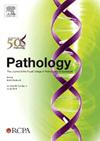Laboratory diagnosis of congenital and acquired coagulopathies, including challenging-to-diagnose rare bleeding disorders
IF 3
3区 医学
Q1 PATHOLOGY
引用次数: 0
Abstract
Coagulation factors, anticoagulant proteins, and fibrinolytic proteins are important for haemostasis and may be altered by inherited and acquired conditions. Common causes of coagulopathies include vitamin K (VK) deficiency (VKD), liver disease, lupus anticoagulants, consumption or disseminated intravascular coagulation, and much less commonly, an inherited or an acquired autoimmune coagulopathy. VKD typically accounts for ≥30% of all coagulopathy referrals, and VKD is particularly common among infants but can occur at any age and in combination with other coagulopathies. Tests for fibrinogen help assess both congenital and acquired coagulopathies, with low levels predictive of poor outcomes from diverse conditions including trauma and postpartum haemorrhage. Inherited factor deficiencies are rarer, and some affect multiple coagulation factors (F), such as combined FV and FVIII deficiency, familial deficiencies of VK-dependent clotting factors, and congenital disorders of glycosylation. Additionally, there are some rare but important disorders that uniquely impair the procoagulant/anticoagulant balance, including F5 mutations that markedly increase tissue factor pathway inhibitor in plasma, causing prolonged prothrombin and activated partial thromboplastin times, without factor deficiencies. THBD mutations that increase functional, soluble thrombomodulin in plasma can also cause bleeding. Other THBD mutations cause thrombomodulin deficiency and a consumptive coagulopathy. Bleeding disorders that result from pathogenic changes to fibrinolysis include autosomal recessive, loss-of-function mutations in SERPINE1 and SERPINF2 and an autosomal dominant gain-of-function mutation affecting PLAU, in the case of Quebec platelet disorder, which causes platelet-dependent increased fibrinolysis. Laboratories need to consider strategies for diagnosing these different conditions.
先天性和获得性凝血病的实验室诊断,包括难以诊断的罕见出血性疾病。
凝血因子、抗凝蛋白和纤溶蛋白对止血很重要,并可能因遗传和获得性疾病而改变。凝血功能障碍的常见原因包括维生素K (VK)缺乏(VKD)、肝脏疾病、狼疮抗凝剂、消耗或弥散性血管内凝血,以及更不常见的遗传或获得性自身免疫性凝血功能障碍。VKD通常占所有凝血病转诊的30%以上,VKD在婴儿中特别常见,但可发生在任何年龄,并与其他凝血病合并。纤维蛋白原检测有助于评估先天性和获得性凝血功能障碍,低水平的纤维蛋白原检测可预测包括创伤和产后出血在内的多种疾病的不良预后。遗传性因子缺乏较为少见,部分影响多种凝血因子(F),如FV和FVIII联合缺乏、家族性vk依赖性凝血因子缺乏、先天性糖基化障碍等。此外,还有一些罕见但重要的疾病会独特地损害促凝/抗凝平衡,包括F5突变,其显著增加血浆中组织因子途径抑制剂,导致凝血酶原延长和部分凝血活酶活化时间,而没有因子缺乏。THBD突变增加血浆中功能性可溶性血栓调节蛋白也可引起出血。其他THBD突变引起血栓调节素缺乏和消耗性凝血病。由纤维蛋白溶解的致病性改变引起的出血性疾病包括常染色体隐性SERPINE1和serinf2的功能丧失突变,以及影响PLAU的常染色体显性功能获得突变,在魁北克血小板疾病的情况下,这会导致血小板依赖性纤维蛋白溶解增加。实验室需要考虑诊断这些不同疾病的策略。
本文章由计算机程序翻译,如有差异,请以英文原文为准。
求助全文
约1分钟内获得全文
求助全文
来源期刊

Pathology
医学-病理学
CiteScore
6.50
自引率
2.20%
发文量
459
审稿时长
54 days
期刊介绍:
Published by Elsevier from 2016
Pathology is the official journal of the Royal College of Pathologists of Australasia (RCPA). It is committed to publishing peer-reviewed, original articles related to the science of pathology in its broadest sense, including anatomical pathology, chemical pathology and biochemistry, cytopathology, experimental pathology, forensic pathology and morbid anatomy, genetics, haematology, immunology and immunopathology, microbiology and molecular pathology.
 求助内容:
求助内容: 应助结果提醒方式:
应助结果提醒方式:


